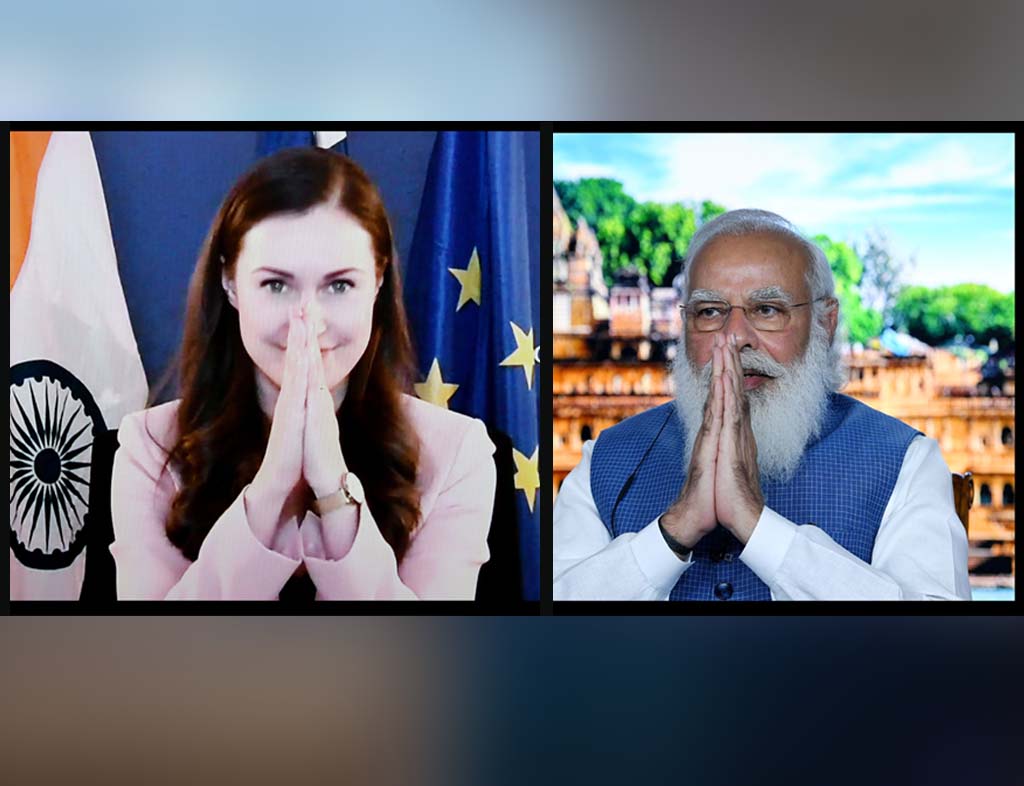

Indian Prime Minister Narendra Modi and Finland PM Sanna Marin during their virtual summit on Tuesday. The two countries will enhance partnership in future mobile technologies, focusing on 6G research and development (Image courtesy: PIB)
<p>
<strong>India and Finland are set to cement ties in the hi-tech domain including 6G technology, quantum computing and Artificial Intelligence.</strong></p>
<p>
Indian Prime Minister Narendra Modi and Finland PM Sanna Marin announced the deepening of bilateral relations, expanding and diversifying the partnership across sectors, especially the Digital Partnership in Future Information and Communication Technologies (ICT), Future Mobile Technologies and Digital Education after their virtual summit on Tuesday.</p>
<p>
Besides discussing an entire gamut of bilateral issues, as well as other regional and multilateral issues of mutual interest, both leaders noted that the digital domain was one of the most promising sectors for an intensive India&minus;Finland partnership.</p>
<p>
According to the Joint Statement issued after the meeting, the emphasis would be in three key future domains:</p>
<p>
– Future ICT, focusing on quantum technologies and computing</p>
<p>
– Future mobile technologies, focusing on 6G research &amp; development</p>
<p>
– Future education, focusing on digital transformation of teaching and learning</p>
<p>
Essential and cross-cutting elements of all these key domains are the utilisation of artificial intelligence, cyber security and blockchain technologies with both Finland and India having a great deal to offer each other in these areas.</p>
<p>
<span style="font-size: 20px;"><strong>Also Read:</strong></span></p>
<p>
<a href="https://www.indianarrative.com/world-news/india-s-north-east-can-help-shape-asia-s-future-says-japan-71292.html" style="font-size: 16px;"><strong>India&#39;s North East can help shape Asia&#39;s future, says Japan</strong></a></p>
<div id="cke_pastebin">
<a href="https://www.indianarrative.com/world-news/how-fbi-and-a-twitter-thread-helped-nepal-get-back-its-stolen-statue-after-years-72597.html" style="font-size: 16px;"><strong>How FBI and a Twitter thread helped Nepal get back its stolen statue after 37 years</strong></a></div>
<p>
&nbsp;</p>
<p>
<strong>Nokia, connecting Finland and India through 6G</strong></p>
<p>
Finnish multinational giant Nokia is expected to play a major role in India&#39;s initiative for research into the next generation of wireless networks. Nokia is already leading the European Union&#39;s 6G project Hexa-X which will connect human, physical and digital worlds with a fabric of 6G technology enablers.</p>
<p>
The company, which has been at the forefront in commercializing every generation of wireless technology, from the first GSM call to 4G networks and fastest 5G speeds, is leading the 6G joint research and pre-standardization process. It expects 6G systems to launch commercially by 2030, following the typical 10-year cycle between generations.</p>
<p>
Last December, Nokia announced that it has begun the production of next generation 5G equipment at its manufacturing site in Chennai in southern India. Nokia was the first to manufacture the 5G New Radio in India and its Chennai plant is a significant contributor to the Indian government&#39;s &#39;Make in India&#39;&#39; initiative to boost domestic manufacturing designed to position India as a manufacturing hub for the latest telecom gear.</p>
<p>
<img alt="India Finland " src="https://www.indianarrative.com/upload/news/india_finland.jpg" style="width: 100%; height: 100%;" /></p>
<div id="cke_pastebin">
<em><strong>The two Prime Ministers now meet in Porto, Portugal, on May 8 during the India-EU27 Leaders&rsquo; meeting&nbsp; (Image courtesy: Twitter/@FinGovernment)</strong></em></div>
<p>
<strong>Why 6G?</strong></p>
<p>
As the global race to 6G intensifies, the European Commission last month adopted its legislative proposal for a strategic European partnership on Smart Networks and Services as a Joint Undertaking, with a public R&amp;I investment of &euro;900 million over the new long-term budget period 2021-2027.</p>
<p>
In a blog post earlier this month, Peter Stuckmann, who currently serves the European Commission as head of unit of Future Connectivity Systems, explains how advanced 5G infrastructures are also an important starting point for 6G technologies in Europe. Quoting a McKinsey Global Institute study, he says that the growth potential in economic activity enabled by 5G and 6G networks and services is estimated to reach around &euro;3 trillion by 2030.</p>
<p>
&quot;6G systems will move us from Gigabit to Terabit capacities and sub-millisecond response times. This will enable new applications such as real-time automation or extended reality sensing (&#39;Internet of Senses&#39;), collecting data for a digital twin of the physical world. Research and Innovation (R&amp;I) initiatives on 6G technologies are now starting around the world, with the first products and infrastructures expected for the end of this decade,&quot; writes Stuckmann.</p>
<p>
He emphasizes that success in 6G will depend on the extent to which Europe succeeds in building a solid 5G infrastructure. Therefore, building 5G lead markets is of key importance.</p>
<p>
&quot;In Europe, a first set of 6G projects worth &euro;60 million was launched under the 5G-PPP, with the Hexa-X flagship developing a first 6G system concept complemented by eight projects investigating specific technologies for 6G. These technologies will form the basis for a human-centric Next-Generation Internet (NGI) and address Sustainable Development Goals (SDGs).&quot;</p>
<p>
<strong>The India connection&nbsp;</strong></p>
<p>
Not just trade and investment but science, innovation, sustainable development and digitalisation could enhance and upgrade India&minus;Finland relationship, bringing it to an upward trajectory.</p>
<p>
Prime Minister Modi yesterday appreciated Finland&#39;s leading role in clean and green technologies and suggested enhanced R&amp;D cooperation in the field of gas-based economy, biofuels, renewable energy, waste-to-energy, electricity storage and emerging fuels such as hydrogen. He also invited Finland to join the International Solar Alliance (ISA) and the Coalition for Disaster Resilient Infrastructure (CDRI).</p>
<p>
With Finland supporting India&rsquo;s efforts to become a permanent member of the UN Security Council, the partnership is only set to grow stronger in the coming times.&nbsp;</p>
<p>
The two Prime Ministers now meet in Porto, Portugal, on May 8 during the India-EU27 Leaders&rsquo; meeting.</p>
As Prime Minister Narendra Modi embarks on a crucial two day visit to Saudi Arabia…
By Ishaan Prakash Almost everywhere one looks, China is ramping up pressure against neighbours and…
Federal Bureau of Investigation Director Kash Patel on Monday (local time) assured that justice will…
India-Saudi Arabia High Level Task Force on Investments held its meeting in Riyadh on Monday,…
United States Vice President JD Vance on Monday said it was an "honour" to meet…
Prime Minister Narendra Modi on Monday welcomed US Vice President JD Vance, his wife Usha…